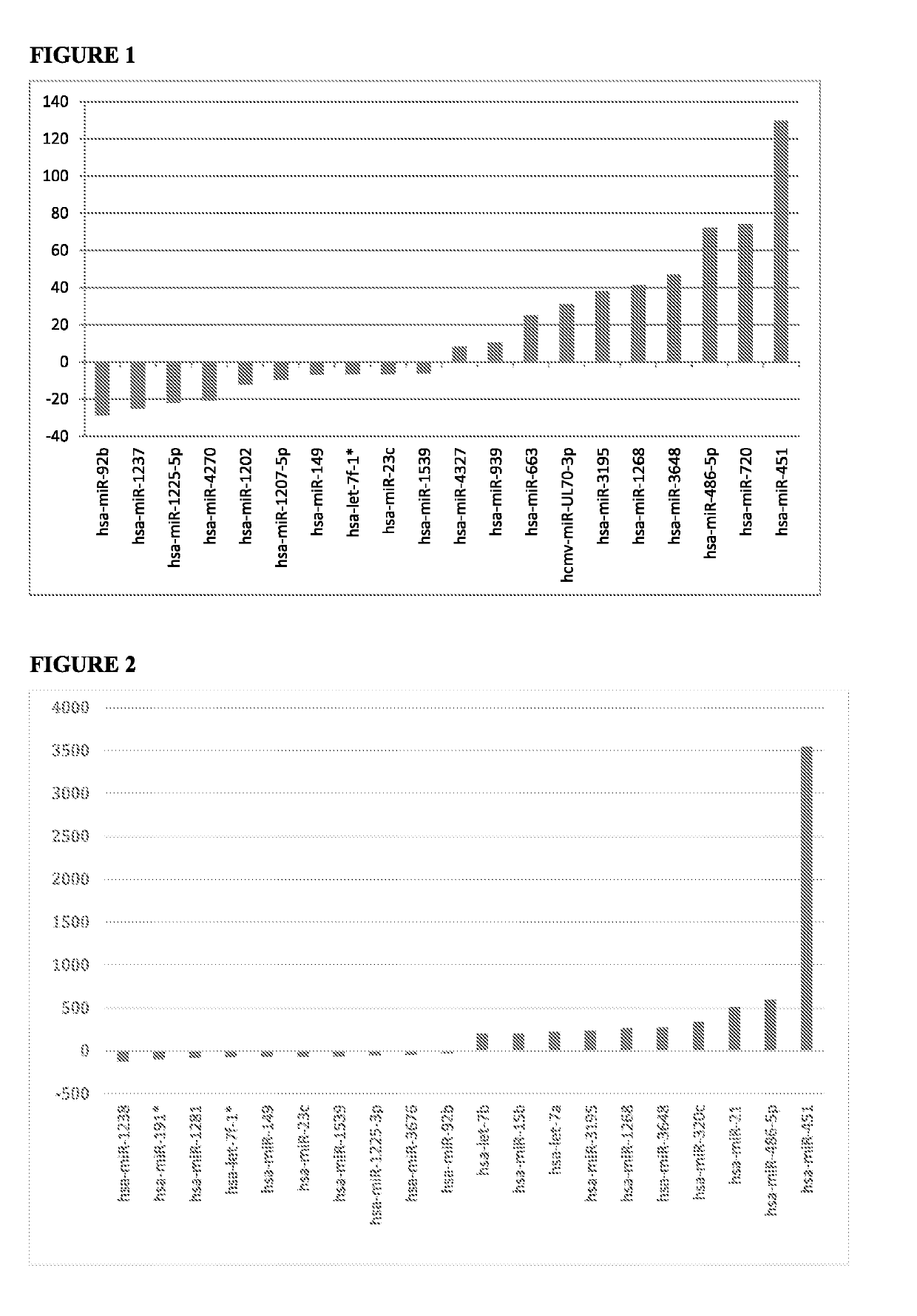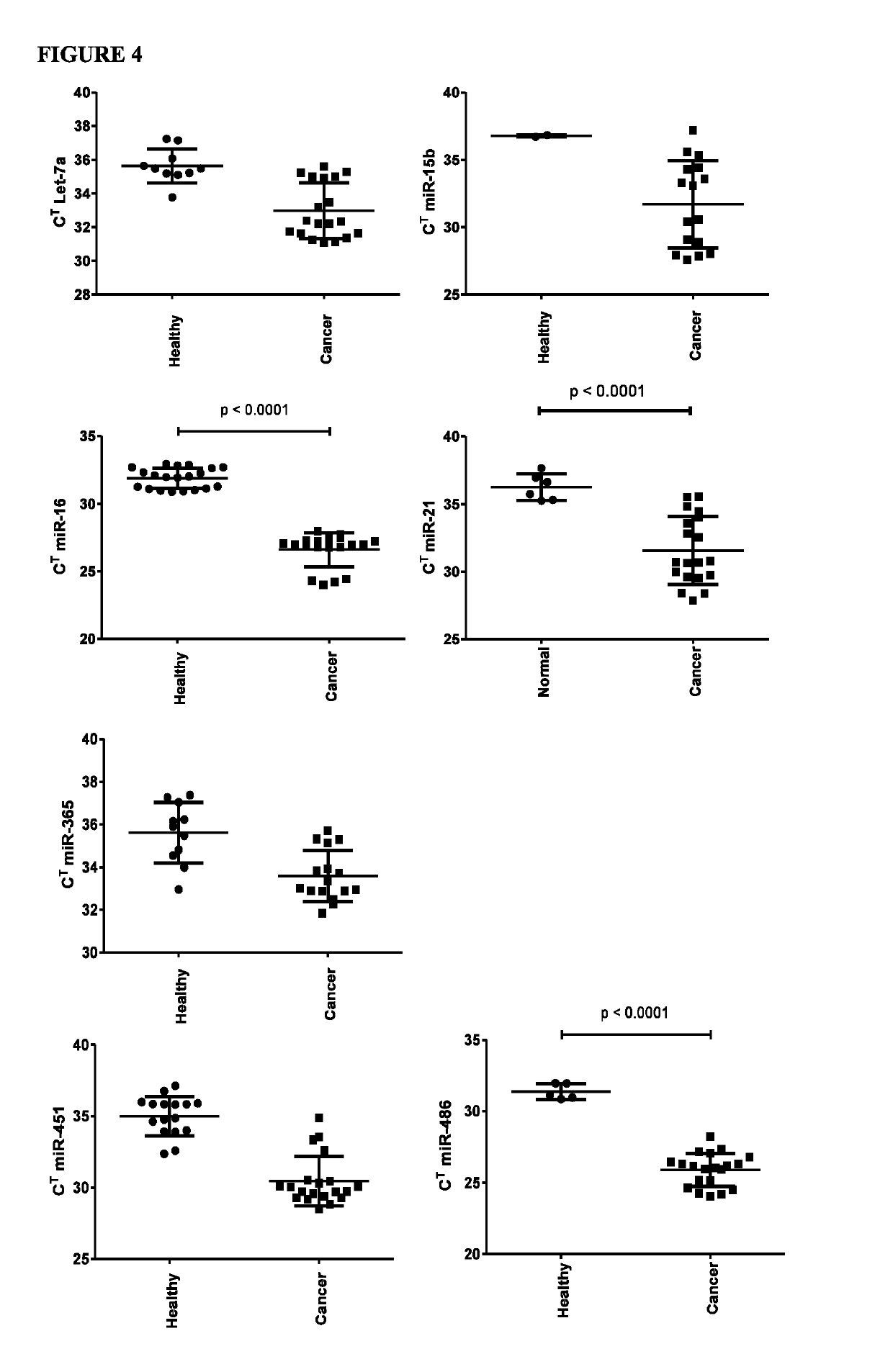Biomarkers of Oral, Pharyngeal and Laryngeal Cancers
a technology of oral pharyngeal and laryngeal cancer and biomarkers, which is applied in the field of head and neck cancer diagnosis and prognosis, can solve the problems of poor prognosis, high morbidity rate, and significant morbidity
- Summary
- Abstract
- Description
- Claims
- Application Information
AI Technical Summary
Benefits of technology
Problems solved by technology
Method used
Image
Examples
example 1
Differential miRNA Expression Between HNSCC and Non-Tumour Control Groups
[0136]The inventors first investigated the expression of miRNAs in the compiled pooled HNSCC serum samples (n=52) compared to the non-tumour control serum samples (n=11). Volcano plot analysis identified 53 miRNAs significantly over expressed (up regulated) in sera from HNSCC subjects compared to sera from non-tumour control subjects, and 40 miRNAs the expression of which was significantly under expressed (down regulated).
[0137]FIG. 1 shows the ten most over expressed and ten most under expressed miRNAs with p-values less than 0.000001 in sera from HNSCC subjects compared to sera from non-tumour control subjects, as determined from the volcano plot analysis. Table 4 presents the p-value and fold change of six of the most over expressed and three of the most under expressed miRNAs from FIG. 1, together with the number of known gene targets of each miRNA.
TABLE 4microRNAp-valueFold changeGene TargetsOver expressed...
example 2
Differential miRNA Expression Between Oral Cavity Tumour Group and Non-Tumour Control Group
[0138]The inventors then investigated the expression of miRNAs in the oral cavity tumour pooled serum samples (n=42) and the non-tumour control samples (n=11). Volcano plot analysis identified 130 miRNAs significantly over expressed (up regulated) in sera from subjects with oral cavity tumours compared to sera from non-tumour control subjects, and 36 miRNAs the expression of which was significantly under expressed (down regulated).
[0139]FIG. 2 shows the ten most over expressed and ten most under expressed miRNAs with p-values less than 0.000001 in sera from subjects with oral cavity tumours compared to sera from non-tumour control subjects, as determined from volcano plot analysis. The majority of differentially expressed miRNA were found to be over expressed (between 100 to 1000 fold increased). The most under expressed miRNA, miR-129-3p, exhibited a relatively modest reduction in expression ...
example 3
Differential miRNA Expression Between Oropharyngeal Tumour Group and Non-Tumour Control Group
[0142]The inventors also investigated the expression of miRNAs in the oropharyngeal tumour pooled serum samples (n=5) and the non-tumour control samples (n=11). Volcano plot analysis identified 19 miRNAs significantly over expressed (up regulated) in sera from subjects with oroparyngeal tumours compared to sera from non-tumour control subjects, and 15 miRNAs the expression of which was significantly under expressed (down regulated).
[0143]FIG. 5 shows the most over expressed and most under expressed miRNAs with p-values less than 0.000001 in sera from subjects with oropharyngeal tumours compared to sera from non-tumour control subjects, as determined from volcano plot analysis. As with the oral cavity tumour sample data (Example 2), the majority of differentially expressed miRNA were found to be over expressed (between 100 to 1000 fold increased).
[0144]The most over expressed miRNA was miR-48...
PUM
| Property | Measurement | Unit |
|---|---|---|
| Time | aaaaa | aaaaa |
Abstract
Description
Claims
Application Information
 Login to View More
Login to View More - R&D
- Intellectual Property
- Life Sciences
- Materials
- Tech Scout
- Unparalleled Data Quality
- Higher Quality Content
- 60% Fewer Hallucinations
Browse by: Latest US Patents, China's latest patents, Technical Efficacy Thesaurus, Application Domain, Technology Topic, Popular Technical Reports.
© 2025 PatSnap. All rights reserved.Legal|Privacy policy|Modern Slavery Act Transparency Statement|Sitemap|About US| Contact US: help@patsnap.com



